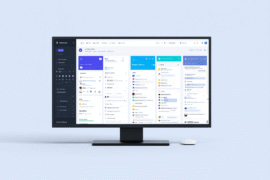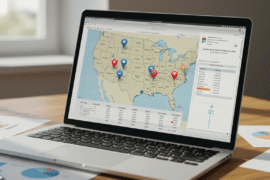This article may contain references to products or services from one or more of our advertisers or partners. We may receive compensation when you click on links to those products or services. Nonetheless, our opinions are our own.
The information presented in this article is accurate to the best of our knowledge at the time of publication. However, information is subject to change, and no guarantees are made about the continued accuracy or completeness of this content after its publication date.
- Apple’s Supply Chain Risks from Tariffs
- Tariffs Push Apple to Shift Production While Costs Continue to Rise
- How Tariffs Affect Apple Users and Tech Budgets
- Apple’s Approaches to Manage Tariff Challenges
- How Tariffs May Impact Apple’s Stock Performance
- Smart Financial Moves to Handle Tariff-Driven Changes
- Analyst Forecasts for Apple’s Global Trade Position
- Remarks to Conclude
- Frequently Asked Questions
- What challenges is Apple facing due to tariffs?
- How do tariffs impact Apple’s pricing strategy?
- What are analysts predicting for Apple’s future sales with the tariff situation?
- Is Apple considering any changes in its supply chain due to tariffs?
- How might tariffs affect Apple’s competitive position in the market?
- What strategies could Apple employ to navigate the tariff challenges?
- Recommended Reads
Apple’s Supply Chain Risks from Tariffs
When you think about tariffs, it might seem like a distant financial concern, but they can considerably ripple through the supply chains of major companies like Apple. As an informed consumer, it’s important to understand how these tariffs can impact not just the prices you see on the Apple store, but also the availability and innovation of the products you love. Here are some considerations:
- Increased Costs: Tariffs frequently lead to higher production costs, which Apple may pass on to you in the form of increased prices for iPhones, Macs, and other products.
- Supply Chain Disruptions: With an intricate global supply chain, any disruption can delay new product launches or affect inventory, making some products hard to find.
- Shifts in Production: Apple may consider relocating some manufacturing processes to countries with lower tariffs, which could affect job markets and production quality.
It’s fascinating to see how Apple responds to these challenges, often with a focus on maintaining competitive prices while also ensuring technological advancement. They may invest in new technologies or automation to mitigate increased costs. Understanding these shifts can help you make informed purchasing decisions and advocate for fair trade practices.
| Impact Category | Potential Effect |
|---|---|
| Price Increases | Higher consumer prices for Apple products |
| Product Availability | Possible delays in product launches |
| Manufacturing Changes | Relocation of production facilities |
Tariffs Push Apple to Shift Production While Costs Continue to Rise
According to Reuters, dated April 2025, new tariffs could cause Apple to raise iPhone prices much more than expected. For example, the most affordable iPhone model, which usually sells for around $600, might jump to over $850 if Apple fully passes on the added costs. Experts say other Apple products like MacBooks could also get more expensive. One industry analyst noted that Apple may need to raise prices by about 30% on average to handle the extra import taxes. These possible increases are much higher than the earlier guess of 10% to 15%, so the expected cost impact may be more serious than it first appeared.
How Tariffs Affect Apple Users and Tech Budgets
As price adjustments ripple through the tech industry, the implications for your financial choices become more pronounced. If you’re a devoted Apple user, you might be pondering the consequences of tariff-driven price hikes. These increases could lead to a direct impact on how much you pay for new devices, accessories, and services. Here are a few things to consider:
- Budget Adjustments: With prices on the rise, it may be time to revisit your budget. Allocate more funds for tech purchases or consider postponing upgrades until prices stabilize.
- Second-Hand Options: Explore the second-hand market for Apple products. You can often find excellent deals on gently used devices that can save you money without sacrificing quality.
- Staying Informed: Keep an eye on market trends. Understanding where pricing might go next can empower you to make timely purchases.
When it comes to planning your tech expenses, it’s important to weigh the benefits of purchasing now against the potential for future savings. Here’s a simple table to visualize how your current plan might adapt with the upcoming changes:
| Current Purchase Plan | Adjusted Plan |
|---|---|
| Buying the newest iPhone | Consider the previous model |
| Upgrading accessories annually | Upgrade every 18 months |
| Always buying new | Explore refurbished options |
Apple’s Approaches to Manage Tariff Challenges
As tariffs continue to impact the tech industry, Apple is exploring various strategies to cushion its financial standing. Here are some approaches they are considering:
- Diversifying Supply Chains: By relocating manufacturing to countries less affected by tariffs, Apple aims to minimize production costs and maintain pricing stability.
- Adjusting Pricing Strategies: You may notice slight increases in product prices that reflect the tariffs. Apple is likely weighing how to balance profitability with competitive pricing.
- Investing in Local Production: By boosting domestic manufacturing, Apple can potentially sidestep some tariff implications while also benefiting from government incentives for job creation.
| Strategy | Potential Benefit | Challenges |
|---|---|---|
| Diversifying Supply Chains | Lower tariffs on imports | Higher initial costs and transition time |
| Adjusting Pricing Strategies | Maintained profit margins | Risk of alienating price-sensitive customers |
| Investing in Local Production | Reduced dependence on foreign markets | Increased labor costs |
Voted "Best Overall Budgeting App" by Forbes and WSJ
Monarch Money helps you budget, track spending, set goals, and plan your financial future—all in one app.
Get 50% OFF your first year with code MONARCHVIP
How Tariffs May Impact Apple’s Stock Performance
As you evaluate your investment portfolio, it’s important to consider the potential impact of tariff challenges on a giant like Apple. Recent insights from analysts suggest that the tech titan may face obstacles due to escalating trade tensions, which could influence its market performance and your returns. Factors to consider include
- Supply Chain Vulnerabilities: Apple’s reliance on global suppliers for components means that tariffs could lead to increased production costs.
- Price Increases: With potential tariffs, Apple might be pressured to hike prices, which could affect consumer demand for their products.
- Market Competition: If Apple’s products become significantly more expensive, competitors could capitalize on this gap, impacting Apple’s market share.
| Analyst Firm | Projected Impact | Short-Term Outlook |
|---|---|---|
| Morgan Stanley | Negative | Hold |
| Goldman Sachs | Neutral | Buy |
| JP Morgan | Positive | Buy |
Smart Financial Moves to Handle Tariff-Driven Changes
As global trade policies shift, you might find it important to rethink how these changes can impact your personal budget and investments. Tariffs can affect the prices of consumer goods, forcing you to reassess your spending habits. Here are some practical steps you can take:
- Review Your Budget: Take a close look at your monthly expenses. Identify areas where you can cut back, especially on non-essential items that could see price hikes.
- Shop Smart: Stay informed about which products are affected by tariffs. Look for alternatives or brands that may not experience the same increases in cost.
- Consider Investing in Domestic Products: Supporting local businesses can help mitigate the impact of tariffs on your finances while fostering community economic growth.
| Investment Type | Risk Level | Potential Return |
|---|---|---|
| Stocks | Moderate to High | Variable |
| Bonds | Low to Moderate | Stable |
| Real Estate | Moderate | Potentially High |
Analyst Forecasts for Apple’s Global Trade Position
As global trade dynamics continue to evolve, analysts are watching how Apple will handle the complexities of tariffs and regulations. The ongoing tensions between major economies have led to uncertainty, impacting not just Apple but the technology industry as a whole. Consider the following challenges Apple could face:
- Increased Production Costs: Tariffs may lead to higher manufacturing expenses, which could be passed on to consumers.
- Market Adaptability: Adapting to new trade policies could strain Apple’s supply chain, forcing changes in sourcing and distribution strategies.
- Price Sensitivity: With potential price hikes, customer demand may fluctuate, posing a risk to Apple’s sales volume.
| Strategy | Description |
|---|---|
| Diversification | Expanding manufacturing to multiple countries to minimize tariff impacts |
| Local Production | Investing in factories closer to key markets to reduce shipping costs and tariffs |
| Pricing Strategies | Adjusting prices strategically to maintain demand without sacrificing profits |
Remarks to Conclude
Tariffs are more than just international trade buzzwords; they directly affect Apple’s operations, product pricing, and your own tech spending habits. From supply chain shifts to price hikes and investor jitters, the impact of tariffs on Apple is multifaceted. While the company adapts through strategic moves, consumers and investors must also prepare for changing costs and market behavior. Staying informed helps you make smarter financial and purchasing decisions in a turbulent global economy.
Frequently Asked Questions
What challenges is Apple facing due to tariffs?
Apple is encountering significant challenges from increased tariffs on products, especially those made in China. These tariffs raise costs for the company and its customers, potentially reducing sales and profits. Supply chain delays and increased overhead may also affect product availability. Overall, Apple must adapt to avoid major financial disruption.
How do tariffs impact Apple’s pricing strategy?
Tariffs lead to higher costs that Apple may pass on to consumers. This results in increased retail prices for many products. Apple has to carefully consider how much of the extra cost customers will tolerate. Their strategy may involve absorbing some costs, adjusting product line pricing, or shifting manufacturing to reduce expenses.
What are analysts predicting for Apple’s future sales with the tariff situation?
Many analysts believe that continued tariffs could slow Apple’s sales growth. Price-sensitive markets may be affected most, where higher prices could discourage purchases. Apple’s brand strength might offset this to some extent, but prolonged trade tension creates long-term uncertainty. Stock ratings reflect cautious optimism, depending on Apple’s strategic response.
Is Apple considering any changes in its supply chain due to tariffs?
Yes, Apple is actively reviewing its supply chain strategy. The company is shifting some production out of China to countries like India and Vietnam. This helps reduce risk from tariffs and ensures production continues smoothly. Diversification also allows Apple to respond more flexibly to global trade shifts.
How might tariffs affect Apple’s competitive position in the market?
Tariffs could make Apple’s products more expensive than competitors’. This could erode their market share if buyers turn to lower-cost alternatives. Rivals not subject to the same trade costs may have a pricing advantage. Apple must rely on its brand loyalty and innovation to maintain a strong market presence.
Apple may boost operational efficiency, renegotiate supplier deals, and invest in domestic production. Other steps include absorbing costs temporarily or adjusting product pricing by region. Diversifying supply chains and increasing automation are also likely. These strategies aim to shield the company from long-term tariff effects.

Reviewed and edited by Albert Fang.
See a typo or want to suggest an edit/revision to the content? Use the contact us form to provide feedback.
At FangWallet, we value editorial integrity and open collaboration in curating quality content for readers to enjoy. Much appreciated for the assist.
Did you like our article and find it insightful? We encourage sharing the article link with family and friends to benefit as well - better yet, sharing on social media. Thank you for the support! 🍉
Article Title: Tariffs vs. Apple: The Cost Impact
https://fangwallet.com/2025/07/04/tariffs-vs-apple-the-cost-impact/The FangWallet Promise
FangWallet is an editorially independent resource - founded on breaking down challenging financial concepts for anyone to understand since 2014. While we adhere to editorial integrity, note that this post may contain references to products from our partners.
The FangWallet promise is always to have your best interest in mind and be transparent and honest about the financial picture.
Become an Insider

Subscribe to get a free daily budget planner printable to help get your money on track!
Make passive money the right way. No spam.
Editorial Disclaimer: The editorial content on this page is not provided by any of the companies mentioned. The opinions expressed here are the author's alone.
The content of this website is for informational purposes only and does not represent investment advice, or an offer or solicitation to buy or sell any security, investment, or product. Investors are encouraged to do their own due diligence, and, if necessary, consult professional advising before making any investment decisions. Investing involves a high degree of risk, and financial losses may occur including the potential loss of principal.
Source Citation References:
+ Inspo
Sriram, A. S. (2025, April 4). A $2,300 Apple iPhone? Trump tariffs could make that happen. A $2,300 Apple iPhone? Trump tariffs could make that happen.











































